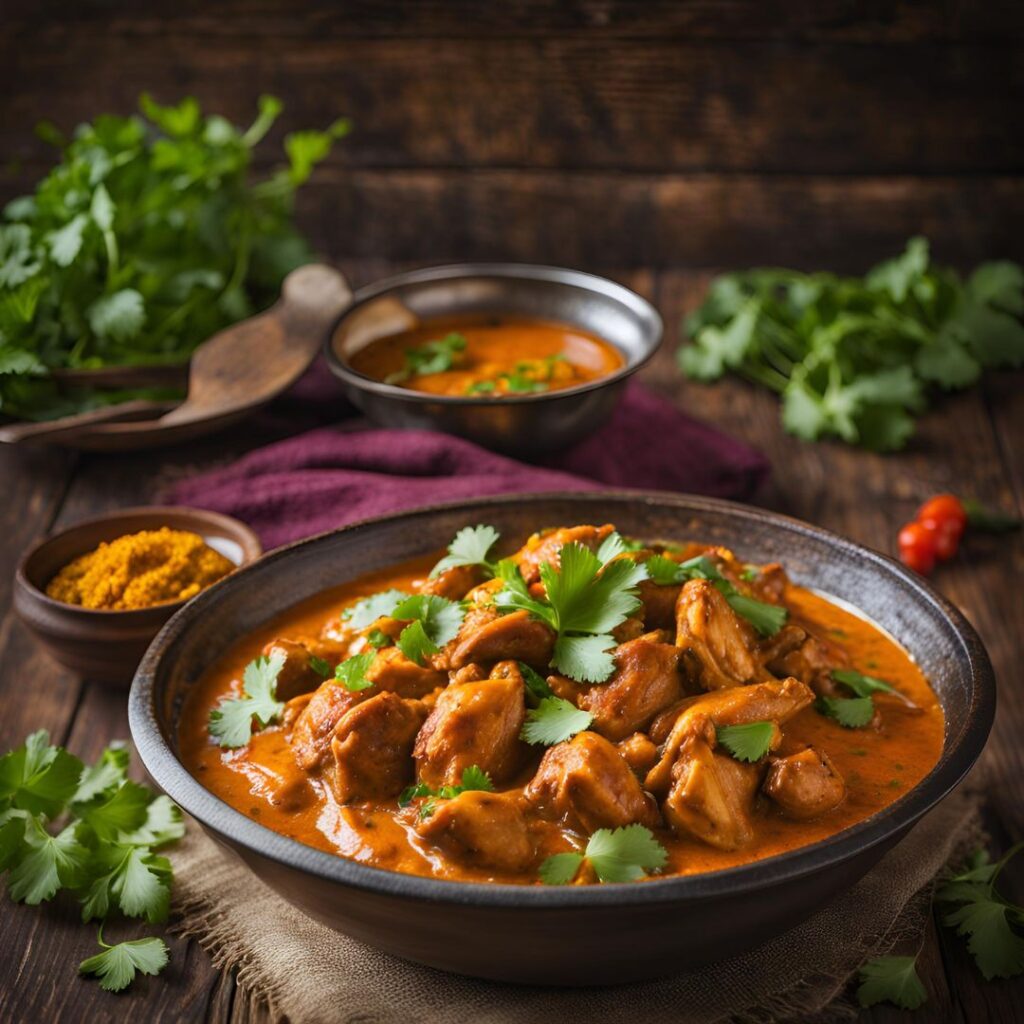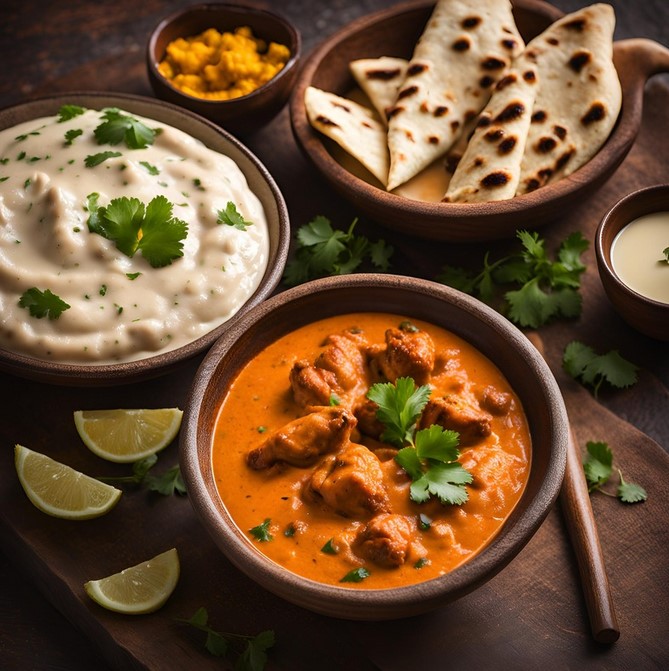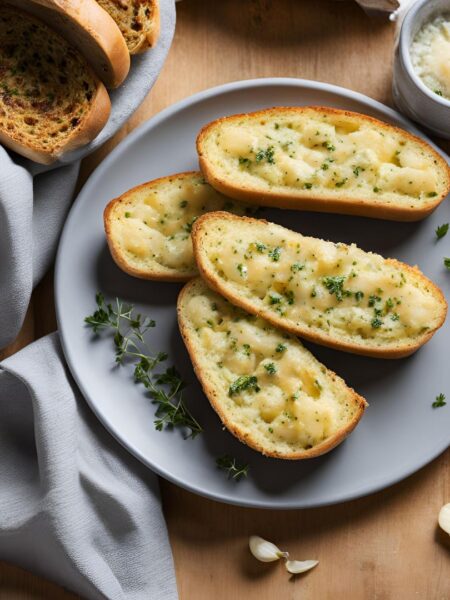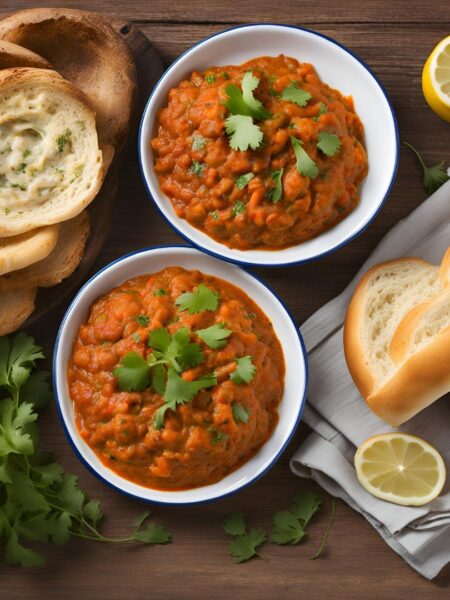Kadai Chicken Recipe : The Bold and Aromatic Delight of Indian Cuisine. When it comes to the rich, diverse tapestry of Indian cuisine, few dishes embody the bold, flavorful essence of Indian cooking as well as Kadai Chicken. Originating from the vibrant culinary traditions of Northern India, this dish stands out for its aromatic spices, fresh ingredients, and its distinctive cooking method. Named after the “kadai”—the traditional wok-like vessel in which it’s cooked—this chicken curry is an absolute favorite in both Indian homes and restaurants across the world.
Kadai Chicken is more than just a meal; it’s a celebration of the symbiotic relationship between spices and heat, a dish that captures the heart of Indian cooking with every bite. The distinct flavors of Kadai Chicken come from the combination of roasted whole spices, a rich onion-tomato gravy, and the perfect tenderness of chicken. The final result is a fiery, aromatic curry that is perfect with naan, roti, or rice. But how did this beloved dish come to be, and what makes it so special?
The Origins of Kadai Chicken
To understand the significance of Kadai Chicken, it’s helpful to delve into the history of Indian cooking and its connection to regional flavors. The “kadai” (or “karahi”) itself is a versatile cooking vessel, similar to a wok, with steep sides and a wide opening. This pan is traditionally used in Indian kitchens to fry, sauté, and prepare a variety of dishes, particularly meat-based curries. While Kadai Chicken has roots in the Punjab region of India, it has become a popular dish in North India and even beyond, gracing tables worldwide.
The origins of Kadai Chicken are tied to the Mughlai influence on Indian cooking. The Mughals, who ruled India from the early 16th to mid-19th centuries, introduced many rich and luxurious cooking techniques and flavors to Indian cuisine. Although Kadai Chicken itself is a relatively modern creation, its foundations lie in the Mughlai love for robust, aromatic gravies made with an array of whole spices, herbs, and slow-cooked meat. The use of whole spices—cumin, coriander, cloves, and black peppercorns—along with tender chicken was a hallmark of Mughal cuisine, and Kadai Chicken builds on these principles, creating a dish that’s both spicy and rich.
Over time, Kadai Chicken evolved with regional influences, incorporating local ingredients and flavor preferences, making it a dish that can be found in virtually every corner of India, as well as in Indian restaurants worldwide.
What Makes Kadai Chicken So Special?
The magic of Kadai Chicken lies in its simplicity and the balance of flavors that come together perfectly. Unlike some Indian curries that rely on yogurt or cream for their richness, Kadai Chicken’s flavor comes from fresh, roasted whole spices, onions, and tomatoes, creating a bold, tangy, and aromatic gravy. The use of a kadai is also integral to the flavor—its shape allows the spices to bloom and infuse the oil, creating a deeper, more complex taste that is not easily replicated in other pans.
There are a few key factors that distinguish Kadai Chicken from other Indian curries:
- The Spice Blend: The roasted whole spices are the cornerstone of Kadai Chicken. Spices such as coriander seeds, cumin seeds, black peppercorns, and dried red chilies are roasted to release their essential oils and flavors before being ground into a coarse powder. This spice blend gives Kadai Chicken its signature, aromatic, and earthy flavor.
- The Cooking Method: Kadai Chicken is cooked in a single pan, which helps the chicken absorb all the aromatic flavors. The technique of sautéing the onions, tomatoes, and spices allows the gravy to thicken and develop rich layers of flavor.
- The Freshness of Ingredients: The use of fresh onions, tomatoes, and green chilies adds brightness and depth to the dish. The tomatoes not only contribute to the color and texture of the gravy but also provide a slight tanginess that complements the warmth of the spices.
- The Tenderness of the Chicken: The chicken is cooked to perfection, soaking up all the spices and becoming tender, juicy, and flavorful. Whether using bone-in or boneless chicken, the meat cooks in the spiced gravy, allowing the flavors to penetrate every bite.
The Flavor Profile of Kadai Chicken
Kadai Chicken strikes a perfect balance between heat, aroma, and richness, making it a crowd-pleaser in any setting. The spice profile of Kadai Chicken is characterized by its earthy, aromatic quality, primarily due to the roasted whole spices. The roasted cumin, coriander, and black pepper lend a warm, slightly smoky flavor to the dish, while the dried red chilies and green chilies add heat that can be adjusted according to preference.
The tangy note of the tomatoes contrasts beautifully with the heat from the spices, creating a flavorful gravy that is not overly rich but perfectly balanced. The dish is further rounded off with a dash of garam masala at the end, adding complexity and depth to the curry without overwhelming the palate. The overall flavor profile is bold but not overwhelmingly spicy, making it a dish that appeals to a wide range of people.
Variations of Kadai Chicken
While the classic version of Kadai Chicken remains a favorite, the dish has also inspired various regional adaptations, each with its own unique twist. Some variations of Kadai Chicken include:
- Kadai Chicken with Bell Peppers: In some regions, capsicum (bell peppers) are added to Kadai Chicken to enhance the flavor and texture. The bell peppers add a slightly sweet note that balances the heat of the curry.
- Kadai Chicken with Cashews: In certain variations, cashews or other nuts are added to the dish, lending a creamy, nutty flavor that complements the spiced gravy. This version is popular in restaurants, where the richness of the dish is enhanced further.
- Kadai Chicken with Yogurt: Some versions include a small amount of yogurt in the gravy, adding a creamy texture and helping to balance the heat and spices. This variation is typically found in more northern regions, where yogurt-based curries are common.
- Dry Kadai Chicken: While many people enjoy Kadai Chicken with gravy, there’s also a dry version of the dish that is less saucy and features chicken pieces cooked in a thick layer of roasted spices and onions. This dry Kadai Chicken is often served as an appetizer or snack.
Kadai Chicken in Indian Culture
In Indian culture, food plays an important role in every aspect of life—be it festivals, celebrations, or family gatherings. Kadai Chicken, with its bold flavors and satisfying texture, is often served during special occasions or at festive meals. It’s a dish that signifies hospitality, and its preparation is often associated with love, care, and tradition.
The dish has become a favorite in Indian restaurants globally, especially in countries with large Indian diaspora communities. Whether enjoyed on a regular weekday meal or at a celebratory feast, Kadai Chicken holds a special place in the hearts of people who appreciate the vibrant, robust flavors of Indian cuisine.
Conclusion: The Timeless Appeal of Kadai Chicken
Kadai Chicken is a quintessential representation of Indian cooking at its finest—a harmonious blend of spices, fresh ingredients, and bold flavors. Whether prepared for a special occasion or as a weekday dinner, this dish offers a unique and unforgettable dining experience. Its roots in Mughlai cuisine, combined with regional influences, give it an unparalleled richness and depth that make it a beloved dish across India and the world.
The enduring popularity of Kadai Chicken lies in its versatility, its complex flavor profile, and its ability to bring people together around the table. It remains a perfect choice for anyone looking to explore the heart of Indian cooking, with its perfect balance of heat, richness, and aroma, ensuring that every bite leaves a lasting impression.
Ingredients: Kadai Chicken Recipe
For the Kadai Masala (Spice Mix):
- 2 tablespoons coriander seeds
- 1 tablespoon cumin seeds
- 1 teaspoon black peppercorns
- 4-5 dried red chilies
- 1 teaspoon fenugreek seeds (optional)
For the Chicken Gravy:
- 500 grams chicken, boneless, skinless, cut into bite-sized pieces
- 2 tablespoons oil (vegetable or mustard oil)
- 1 medium onion, finely chopped
- 1 tablespoon ginger-garlic paste
- 2 tomatoes, finely chopped or blended
- 2-3 green chilies, slit (optional, for added heat)
- 1/2 teaspoon turmeric powder
- 1 teaspoon red chili powder
- 1 teaspoon ground coriander
- 1/2 teaspoon garam masala powder
- Salt to taste
- 1/4 cup water (or as needed)
- 1/4 cup fresh coriander (cilantro), chopped for garnish
Cooking Instructions: Kadai Chicken Recipe
1. Prepare the Kadai Masala (Spice Mix):
- Dry roast the coriander seeds, cumin seeds, black peppercorns, dried red chilies, and fenugreek seeds (if using) in a pan on medium heat. Stir continuously for about 2-3 minutes until the spices become fragrant.
- Let the roasted spices cool down slightly before grinding them into a coarse powder using a spice grinder or mortar and pestle. Set this aside.
2. Cook the Chicken:
- Heat 2 tablespoons of oil in a large kadai (or wok) over medium-high heat. Add the chopped onions and sauté them until they turn golden brown, about 7-10 minutes. Stir occasionally to avoid burning.
- Add the ginger-garlic paste and green chilies (if using), and cook for another 1-2 minutes until fragrant.
- Add the chopped tomatoes and cook for about 5-7 minutes, or until the tomatoes break down and turn into a thick paste. Stir frequently to prevent sticking.
3. Add the Spices:
- Stir in the turmeric powder, red chili powder, ground coriander, and salt. Cook the mixture for 2-3 minutes to allow the spices to bloom and blend with the tomato paste.
- Once the spice mix has cooked through, add the chicken pieces to the pan. Toss the chicken pieces well to coat them with the spices and onion-tomato paste.
4. Simmer the Chicken:
- Add the freshly ground Kadai masala (spice mix) to the chicken and stir well to combine.
- Pour in about 1/4 cup of water to help create the gravy. Cover the pan and cook the chicken on medium heat for 15-20 minutes, or until the chicken is cooked through and tender. Stir occasionally and check the consistency of the gravy. If it thickens too much, add a little more water.
5. Final Touches:
- Once the chicken is fully cooked, check the seasoning and adjust salt or spice levels if needed. Sprinkle the garam masala powder over the chicken and stir.
- Garnish with freshly chopped coriander (cilantro) leaves.
6. Serve:
- Serve hot with naan, roti, or steamed rice. Kadai Chicken can also be paired with jeera rice or biryani for a complete meal.
Total Time Breakdown:
- Preparation Time: 15 minutes (for chopping, grinding spices, etc.)
- Cooking Time: 30-40 minutes
- Total Time: 45-55 minutes
Number of Servings:
This recipe serves 4 people.
Essential cooking tips for Kadai Chicken recipe
1. Roast the Whole Spices for Maximum Flavor
- The roasted whole spices are the heart of Kadai Chicken, and they’re essential for creating that bold, aromatic flavor that defines the dish. Roasting the spices helps release their essential oils, intensifying their flavor and aroma.
- Dry roast the coriander seeds, cumin seeds, black peppercorns, anddried red chilies in a pan over medium heat until they become fragrant (2-3 minutes). Let them cool slightly before grinding them into a coarse powder using a spice grinder or mortar and pestle. This freshly ground spice mix will form the foundation of your Kadai Chicken’s flavor.
2. Use a Kadai (Wok) for Authentic Flavor
- The kadai (or karahi) is a traditional Indian wok-like vessel that’s typically used for cooking Kadai Chicken. The wide, deep shape of the kadai allows the spices to bloom and infuse the oil more evenly, giving the curry a deeper, richer flavor. It also helps in sautéing the chicken and spices evenly, ensuring that the flavors meld together perfectly.
- If you don’t have a kadai, use a wok or a heavy-bottomed pan to get a similar result. Ensure that the pan is wide and deep enough to allow the chicken to cook evenly and for the spices to fry properly.
3. Caramelize the Onions to Build Flavor
- Onions provide a base for many Indian curries, and in Kadai Chicken, they contribute both texture and sweetness to balance the spices. Caramelizing the onions until they are golden-brown adds richness and depth to the curry. The slow-cooked onions also help thicken the gravy, creating a more flavorful sauce.
- Don’t rush this step. Sauté the chopped onions over medium-low heat for 7-10 minutes until they turn golden brown. Stir occasionally to avoid burning, as caramelized onions contribute a deep, savory sweetness to the dish.
4. Balance the Heat with Tomatoes and Garam Masala
- Kadai Chicken has a spicy profile, but it’s important to balance the heat with the right amount of acidity and complexity. Tomatoes provide a tangy contrast to the heat of the chilies, while garam masala adds aromatic warmth to the final dish.
- After cooking the onions and ginger-garlic paste, add the chopped tomatoes and cook them down until they form a thick paste. This will provide a tangy base for the gravy. After the chicken is cooked, add garam masala at the end to boost the complexity of the flavor without overwhelming the dish with too much spice.
5. Cook the Chicken in the Spices to Infuse Flavor
- The key to a flavorful Kadai Chicken is to allow the chicken to absorb the spices while it cooks. Searing the chicken in the spices gives it a crispy exterior and ensures that each piece is packed with flavor. Simmering the chicken in the spiced gravy also helps it soak up all the aromatic goodness.
- Once you add the chicken to the pan, stir it well to coat the pieces in the spice mixture. Let the chicken cook uncovered for about 15-20 minutes, stirring occasionally. This allows the meat to cook through while soaking up the flavors of the masala. You can add a little water or chicken broth to adjust the consistency of the gravy, but make sure the chicken remains the star of the dish.
Some More Interesting Recipes –
- Chicken Tikka Masala Recipe
- Butter Chicken Recipe
- Chicken Jalfrezi Recipe
- Mughlai Chicken Recipe
- Mutton Biryani Recipe
- Prawn Biryani Recipe
- Chettinad Biryani Recipe
- Chicken Pulao Recipe
- Tandoori Chicken Recipe
- Chicken Korma Recipe
- Dahi Chicken Recipe
- Malai Kofta Recipe
- Lemon Rice Recipe
- Chicken Fried Rice Recipe
- Vegetable fried rice Recipe
- Andhra Chicken Biryani Cooking Recipe
- Hyderabadi Chicken Biryani Recipe
- Vegetable Pulao Recipe
Important FAQs – Kadai Chicken Recipe
1. Can I make this recipe of Kadai Chicken with boneless chicken?
Yes, you can use boneless chicken for Kadai Chicken. Boneless chicken breasts or thighs work well and cook faster than bone-in chicken. However, bone-in chicken tends to have more flavor, so using bone-in pieces will give your curry a richer taste. If you opt for boneless, just reduce the cooking time by a few minutes.
2. What is the difference between recipe of Kadai Chicken and Chicken Masala?
The main difference lies in the spices and cooking method. Kadai Chicken is cooked with a freshly ground spice mix, including roasted whole spices like coriander, cumin, and black pepper, which gives it a distinct, bold flavor. Chicken Masala, on the other hand, is typically made with a pre-made garam masala or simpler ground spices and has a more straightforward, less complex flavor profile. Kadai Chicken is also often cooked in a kadai (Indian wok-like vessel), adding to its unique taste.
3. Can I make this recipe of Kadai Chicken without a kadai or wok?
Yes, you can. While a kadai is ideal for making this dish because of its shape and heat distribution, you can make Kadai Chicken in any heavy-bottomed pan, such as a skillet or Dutch oven. Just ensure that the pan you use can handle high heat and provide even cooking.
4. How do I make Kadai Chicken less spicy with this recipe?
If you prefer a milder version of Kadai Chicken, you can reduce the heat by:
- Omitting or reducing the amount of green chilies and dried red chilies used in the recipe.
- Reducing the chili powder or using a mild chili powder.
- Adding a bit of cream or yogurt at the end to mellow out the spiciness.
- Using less garam masala, as it can sometimes add an unexpected level of heat depending on the blend.
5. Can I make Kadai Chicken in advance with this recipe?
Yes, Kadai Chicken can be made ahead of time. In fact, like many curries, it often tastes better the next day as the flavors have had time to meld together. You can make it up to 2 days in advance and store it in the refrigerator. Reheat it on the stovetop and add a little water or stock if the gravy has thickened too much.
6. What can I serve with Kadai Chicken made with this recipe?
Kadai Chicken pairs wonderfully with naan, roti, or paratha, which are great for scooping up the flavorful gravy. You can also serve it with steamed basmati rice, jeera rice (cumin rice), or pilaf for a more filling meal. For a lighter option, consider pairing it with a simple salad or a bowl of raita (yogurt with cucumber and spices) to balance the richness of the curry.
7. Can I make a vegetarian version of this Kadai Chicken recipe?
Yes, you can easily make a vegetarian version of Kadai Chicken by replacing the chicken with paneer (Indian cottage cheese), tofu, or a variety of vegetables like cauliflower, bell peppers, or potatoes. The cooking method remains the same, though the cooking times may vary depending on the ingredient used. Paneer and tofu cook quickly, so add them towards the end of the cooking process.
8. What is the best way to store leftover Kadai Chicken made with this recipe?
Leftover Kadai Chicken can be stored in an airtight container in the refrigerator for up to 2-3 days. If you want to store it for a longer period, you can freeze it for up to 2-3 months. To reheat, defrost in the refrigerator overnight, then warm it gently on the stovetop with a splash of water or chicken broth to loosen the gravy.
9. Can I use store-bought masala for this Kadai Chicken Recipe?
While making your own freshly ground kadai masala (spice blend) is highly recommended for the best flavor, you can use store-bought Kadai masala powder as a shortcut. However, keep in mind that the flavor will be less intense and aromatic than when you roast and grind your own spices. If using store-bought masala, you can enhance the flavor by adding extra freshly ground cumin, coriander, and black pepper.
10. How can I thicken the gravy in this recipe of Kadai Chicken?
If your Kadai Chicken gravy is too thin, here are a few ways to thicken it:
- Simmer the gravy uncovered for a longer time to reduce it and concentrate the flavors.
- Grind some of the cooked onions or tomatoes and add them back into the gravy to thicken it naturally.
- Add a handful of ground almonds or cashews (soaked and blended) to create a creamy, thick texture.
- Use a slurry of cornstarch and water (about 1 teaspoon cornstarch in 2 tablespoons water), adding it slowly to the curry until the desired consistency is reached.
11. How can I make Kadai Chicken more flavourful using this recipe?
To enhance the flavors of Kadai Chicken:
- Use fresh, high-quality spices and toast them yourself for a more intense flavor.
- Cook the chicken until it’s browned before adding the tomatoes and spices. This adds depth and richness to the gravy.
- Finish with a squeeze of lemon juice just before serving to brighten up the dish and balance the flavors.
- Garnish with fresh cilantro to add a fresh, herby note.
Kadai Chicken Recipe

Ingredients: Kadai Chicken Recipe
For the Kadai Masala (Spice Mix):
For the Chicken Gravy:
Cooking Instructions: Kadai Chicken Recipe
1. Prepare the Kadai Masala (Spice Mix):
- • Dry roast the coriander seeds, cumin seeds, black peppercorns, dried red chilies, and fenugreek seeds (if using) in a pan on medium heat. Stir continuously for about 2-3 minutes until the spices become fragrant.
- • Let the roasted spices cool down slightly before grinding them into a coarse powder using a spice grinder or mortar and pestle. Set this aside.
2. Cook the Chicken:
- • Heat 2 tablespoons of oil in a large kadai (or wok) over medium-high heat. Add the chopped onions and sauté them until they turn golden brown, about 7-10 minutes. Stir occasionally to avoid burning.
- • Add the ginger-garlic paste and green chilies (if using), and cook for another 1-2 minutes until fragrant.
- • Add the chopped tomatoes and cook for about 5-7 minutes, or until the tomatoes break down and turn into a thick paste. Stir frequently to prevent sticking.
3. Add the Spices:
- • Stir in the turmeric powder, red chili powder, ground coriander, and salt. Cook the mixture for 2-3 minutes to allow the spices to bloom and blend with the tomato paste.
- • Once the spice mix has cooked through, add the chicken pieces to the pan. Toss the chicken pieces well to coat them with the spices and onion-tomato paste.
4. Simmer the Chicken:
- • Add the freshly ground Kadai masala (spice mix) to the chicken and stir well to combine.
- • Pour in about 1/4 cup of water to help create the gravy. Cover the pan and cook the chicken on medium heat for 15-20 minutes, or until the chicken is cooked through and tender. Stir occasionally and check the consistency of the gravy. If it thickens too much, add a little more water.
5. Final Touches:
- • Once the chicken is fully cooked, check the seasoning and adjust salt or spice levels if needed. Sprinkle the garam masala powder over the chicken and stir.
- • Garnish with freshly chopped coriander (cilantro) leaves.
6. Serve:
- • Serve hot with naan, roti, or steamed rice. Kadai Chicken can also be paired with jeera rice or biryani for a complete meal.





